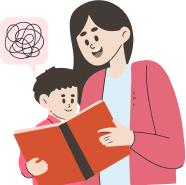Many parents worry when their child can spin endless stories aloud but struggles to put even a few words on paper. It feels like a gap between imagination and writing.
This is where narrative writing in kindergarten makes all the difference. By guiding children to shape their thoughts into simple story structures, you help them build confidence, clarity, and a lifelong love for writing.
In this blog, you’ll learn what narrative writing means for kindergartners, the steps to teach it effectively, practical tips to support storytelling at home, and real examples of early narratives.
Key Takeaways
-
Narrative writing in kindergarten bridges the gap between spoken stories, drawings, and early written expression.
-
Children progress by listening to stories, retelling experiences, and connecting oral language with simple written sentences.
-
Tools like drawings, sentence starters, and word banks give structure while keeping writing playful and engaging.
-
Sequencing events into beginnings, middles, and endings helps young learners organize thoughts into complete stories.
-
Encouragement, modeling, and practical examples build confidence and set realistic expectations for early writing growth.
What is Narrative Writing in Kindergarten?

Narrative writing in Kindergarten means helping children tell stories about real or imaginary events. Your kindergartner combines drawing, speaking, and simple writing to share their experiences or creative ideas. This foundational skill bridges their natural storytelling abilities with formal writing development.
At this age, narrative writing focuses on:
Personal Experiences
-
Family trips or special days.
-
Playing with friends or pets.
-
New experiences, like losing a tooth, can be memorable.
Creative Stories
-
Adventures with favorite toys.
-
Imaginary friends and magical places.
-
Simple plots with characters they create.
Sequential Events
-
What happened first, next, and last?
-
Connecting ideas with fundamental transitions.
-
Building stories that make sense.
Your kindergartner might write one sentence and draw a detailed picture. This combination of visual and written storytelling is precisely what they should be doing at this stage. The drawing supports their writing fluency and helps them express complex ideas that they cannot yet write.
The goal is not perfect grammar or long paragraphs. You want to nurture their natural storytelling abilities and help them see writing as a fun way to share their thoughts.
How to Teach Narrative Writing in Kindergarten?

Teaching narrative writing to kindergartners requires patience and creativity. You build on their natural love of stories and gradually introduce writing skills. The process should feel like play rather than formal instruction.
Start with what your child already knows how to do well. They can tell stories, draw pictures, and talk about their experiences. These existing skills become the foundation for written narratives.
Here are the essential steps to guide your kindergartner through narrative writing development:
Step 1: Introduce Stories Through Read-Alouds and Talk
Reading aloud naturally exposes your kindergartner to story language and structure. They hear how authors begin stories, describe characters, and create interesting events. This exposure helps build their understanding of how narratives work, without formal instruction.
Start by making read-alouds a daily habit and actively discussing the stories you share:
Read Stories Together Daily
-
Choose books with simple plots and clear characters.
-
Point out story elements.
-
Ask questions about what might happen next.
Discuss Story Structure
-
Talk about who is in the story (characters)
-
Identify where the story takes place (setting)
-
Discuss what happens in the story (plot)
Connect Stories to Real Life
-
Compare story events to your child's experiences.
-
Ask how they would handle similar situations.
-
Encourage them to share similar personal stories.
Step 2: Connect Drawing to Writing
Many kindergartners can express complex ideas through pictures before they can write them down. Drawing gives children confidence and helps them organize their thoughts before attempting written narratives.
Use these strategies to bridge visual storytelling with written expression:
Start with Picture Stories
-
Let your child draw pictures about their experiences.
-
Ask them to tell you about their drawings.
-
Write their words under or next to their photographs.
Use Drawing as Prewriting
-
Encourage detailed drawings before writing.
-
Help them add speech bubbles or labels.
-
Show how pictures can give ideas for writing.
Combine Visual and Written Elements
-
Accept drawings as part of their stories.
-
Celebrate creative visual details.
-
Help them see how pictures support their words.
Step 3: Use Sentence Starters and Word Banks
Many kindergartners struggle with the blank page problem and are unsure of how to begin their stories. Providing structure through sentence frames and word lists gives them confidence to start writing.
These tools provide scaffolding while still allowing creative expression and personal voice:
Provide Simple Sentence Frames
-
"One day I..." for personal narratives.
-
"My favorite..." for descriptive stories.
-
"I remember when..." for memory stories.
Create Word Banks Together
-
List describing words (big, little, funny, scary)
-
Include feeling words (happy, sad, excited, worried)
-
Add action words (ran, jumped, played, laughed)
Model Using the Tools
-
Show how sentence starters help begin stories.
-
Demonstrate choosing words from the word bank.
-
Practice using the supports together first.
Step 4: Guide Story Sequencing with Beginning, Middle, End
Understanding basic story structure helps kindergartners organize their thoughts and create narratives that make sense to readers. This framework prevents rambling and helps young writers stay focused.
Introduce sequence concepts through these practical approaches:
Teach Simple Story Structure
-
Beginning: Who and where (setting up the story)
-
Middle: What happens (the main events)
-
End: How it finishes (conclusion or feeling)
Practice with Familiar Events
-
Use daily routines as story examples.
-
Break family activities into three parts.
-
Help them identify the parts of a story in books.
Use Visual Organizers
-
Draw three boxes for the beginning, middle, and end.
-
Help them sketch ideas in each section.
-
Let them tell their story using the visual guide.
Step 5: Encourage Oral Storytelling Before Writing
Speaking helps children organize their ideas and build confidence before attempting written narratives. Oral storytelling allows your child to practice story elements without worrying about spelling or handwriting.
Develop their verbal narrative skills through these activities:
Start with Speaking
-
Let them tell stories out loud first.
-
Record their verbal stories if possible.
-
Ask follow-up questions to add details.
Practice Retelling
-
Have them retell favorite books or movies.
-
Encourage retelling daily events at dinner.
-
Help them practice telling stories to family members.
Build from Oral to Written
-
Write down their spoken stories together.
-
Help them see how speech becomes writing.
-
Show the connection between talking and writing.
Also Read: 50 Creative Writing Exercises to Inspire Younger Writers
Once you've established these teaching foundations, it's helpful to see what successful kindergarten narratives actually look like in practice.
Kindergarten Narrative Writing Examples

Understanding what good kindergarten narrative writing looks like helps you set appropriate expectations and celebrate your child’s progress. The examples below show realistic achievement levels for this age group.
Example 1: Personal Experience Story
My Dog Rex
Yesterday, my dog Rex ran away. I was scared. We looked everywhere. Dad found him under the porch. Rex was sleeping! I was so happy.
This example shows:
-
Clear sequence of events
-
Personal experience focus
-
Simple sentence structure
-
Emotional connection (scared, happy)
-
Problem and resolution
Example 2: Creative Story
The Magic Pencil
I found a magic pencil. It drew pictures that came alive! I drew a butterfly. It flew around my room. Then I drew ice cream. It was delicious! Magic pencils are the best.
This example demonstrates:
-
Imaginative content
-
Cause and effect relationships
-
Descriptive details
-
Personal opinion at the end
-
Creative problem-solving
Example 3: Family Event
Going to Grandma's House
We drove to Grandma's house on Saturday. The trip took forever! Grandma made cookies for us. We played games and watched movies. I didn't want to go home.
This example includes:
-
Time and place details
-
Personal feelings (took forever, didn't want to leave)
-
Multiple events in sequence
-
Family connections
Notice how these examples combine simple sentences with personal voice. The writing focuses on telling a complete story rather than perfect grammar or sophisticated vocabulary.
Also Read: How to Help Your Child Struggling with Writing Skills
With these examples in mind, let's look at some tips that you can use to develop your child’s narrative abilities.
Practical Tips for Story Writing in Kindergarten

These detailed strategies help you support your child's narrative and persuasive writing development while keeping the experience positive and engaging. Each tip builds on kindergarten-appropriate skills and interests.
Start with Storytelling and Read-Alouds
Building narrative skills begins with exposure to quality stories and developing your kindergartners' listening abilities.
Create Daily Story Time
-
Read together for at least 15-20 minutes daily.
-
Choose books with engaging characters and clear plots.
-
Vary between fiction and non-fiction narratives.
Encourage Active Listening
-
Pause during reading to predict what happens next.
-
Ask questions about character feelings and motivations.
-
Connect story events to your child's experiences.
Model Storytelling Language
-
Use transition words like "first," "then," and "finally".
-
Demonstrate descriptive language through your own stories.
-
Show enthusiasm for storytelling through your tone and expression.
Regular exposure to high-quality narratives helps your kindergartner develop a deeper understanding of story structure and vocabulary. They internalize patterns they hear repeatedly.
Understand Story Structure
Once your child enjoys listening to stories, help them recognize how narratives are organized and constructed.
Teach the Story Mountain
-
Draw a simple mountain shape to show story progression.
-
Mark the beginning (characters and setting) at the bottom.
-
Show the middle (problem or main events) at the peak.
-
Indicate the end (solution or conclusion) by going down.
Practice with Daily Events
-
Turn routine activities into structured stories.
-
Help them identify the beginning, middle, and end of their day.
-
Use family photos to practice sequencing events.
Use Story Maps
-
Create simple visual organizers for planning.
-
Include boxes for who, where, what happened, and how it ended.
-
Let them draw or write in each section.
Understanding story structure helps kindergartners organize their thoughts before writing. This planning reduces frustration and improves story quality.
Identify Characters
Strong characters form the heart of every good story and give your kindergartner a focal point for their narratives.
Start with People They Know
-
Encourage stories about family members, friends, and pets.
-
Help them describe characters using simple traits.
-
Show how characters drive story events.
Develop Character Details
-
Ask what the character looks like, acts like, and feels.
-
Help them give characters names and simple personalities.
-
Show how characters can solve problems or face challenges.
Use Character Webs
-
Draw the character in the center of a page.
-
Add describing words or pictures around the character.
-
Help them use these details in their stories.
Strong characters make stories more interesting and give kindergartners a focal point for their narratives.
Describe the Setting
After establishing characters, help your child create vivid settings that bring their stories to life.
Connect Settings to Experience
-
Start with familiar places, such as home, school, or parks.
-
Help them notice details about places they visit.
-
Encourage descriptive language about settings.
Use All Five Senses
-
Ask what they see, hear, smell, taste, or feel in the setting.
-
Help them add sensory details to their stories.
-
Demonstrate how setting details enhance the vividness of stories.
Draw Settings First
-
Let them sketch where their story takes place.
-
Add labels or descriptions to their drawings.
-
Use the picture to inspire written descriptions.
Rich settings help readers visualize the story and provide context for events.
Develop a Basic Plot
With characters and setting established, guide your kindergartner in creating engaging but straightforward storylines.
Focus on Simple Events
-
Help them choose one main thing that happens.
-
Break complex events into smaller, manageable pieces.
-
Demonstrate how events connect to form a complete narrative.
Use Problem and Solution
-
Introduce simple problems that characters can solve.
-
Help them think of realistic solutions.
-
Show how problems make stories enjoyable.
Practice Cause and Effect
-
Help them understand that actions have consequences.
-
Show how one event leads to another.
-
Use "because" and "so" to connect ideas.
A straightforward plot gives direction to kindergarten narratives and helps young writers stay focused.
Introduce a Simple Problem
Adding age-appropriate problems to stories creates interest and gives characters motivation for their actions.
Start with Relatable Problems
-
Lost toys, hurt feelings, or minor accidents.
-
Problems they've experienced or can imagine.
-
Issues with clear, achievable solutions.
Show Problem-Solution Patterns
-
Read books that follow this structure.
-
Help them identify problems and solutions in stories.
-
Practice creating problems and solutions together.
Keep Problems Age-Appropriate
-
Focus on the everyday challenges kindergartners face.
-
Avoid scary or overwhelming situations.
-
Choose problems that characters can realistically solve.
Problems add interest to stories and give characters motivation for their actions.
Encourage Use of Details
Help your child add specific, vivid details that make their stories come alive for readers.
Ask Specific Questions
-
"What did it look like?" for visual details.
-
"How did you feel?" for emotional connections.
-
"What happened next?" for sequence details.
Model Adding Details
-
Show how details make stories more interesting.
-
Demonstrate adding adjectives and descriptive phrases.
-
Read examples of detailed writing from children's books.
Celebrate Specific Language
-
Praise when they use precise words instead of general ones.
-
Help them replace "good" or "nice" with more specific descriptions.
-
Create lists of interesting descriptive words together.
Details bring stories to life and help readers connect with the narrative.
Model and Practice Sentence Starters
Providing varied sentence beginnings helps your child avoid repetitive writing patterns while expressing different types of ideas.
Provide Varied Beginnings
-
Time starters: "Yesterday," "One morning," "After school"
-
Feeling starters: "I was excited when," "I felt scared because"
-
Action starters: "We ran to," "I jumped over," "Mom called"
Practice Together
-
Start sentences and let them finish the ideas.
-
Take turns adding sentences to collaborative stories.
-
Demonstrate how different starters evoke distinct story moods.
Create Starter Collections
-
Make lists of proper sentence beginnings.
-
Sort starters by type (time, feeling, action).
-
Let them choose starters that match their stories.
Varied sentence starters prevent repetitive writing and help kindergartners express different types of ideas.
Use Drawing to Support Writing
Integrating visual elements with written narratives gives your child multiple ways to express their creative ideas.
Integrate Art and Writing
-
Let them draw before, during, or after writing.
-
Show how pictures can inspire written ideas.
-
Accept drawings as legitimate parts of their narratives.
Add Labels and Captions
-
Help them label parts of their drawings.
-
Write simple captions describing picture details.
-
Show how words and pictures work together.
Create Comic-Style Stories
-
Use speech bubbles for character dialogue.
-
Break stories into panels like comics.
-
Let them tell stories through picture sequences.
Drawing supports kindergarten writing development, providing children with multiple ways to express their ideas.
Celebrate Creative Choices and Personal Experiences
Building confidence through positive reinforcement motivates your kindergartner to continue developing their narrative writing skills.
Value Their Ideas
-
Show genuine interest in their story topics.
-
Ask questions that demonstrate your engagement.
-
Avoid critiquing their creative choices.
Share Their Stories
-
Read their stories to family members.
-
Display their writing in special places.
-
Create simple books from their stories.
Positive reinforcement builds writing confidence and motivates kindergartners to continue developing their narrative skills.
Also Read: Best Creative Writing Tools for Kids in 2025
While these home strategies provide excellent support, many parents find that structured programs accelerate their child's progress significantly and boost creative writing skills. This is where FunFox can help boost your child’s narrative writing skills.
How does FunFox support Narrative Writing Skills?

FunFox Writers Club helps children strengthen their storytelling skills in ways that feel exciting and fun. Our teachers build on your child’s natural storytelling abilities through engaging activities that make writing enjoyable and confidence-boosting.
With small groups of no more than six students, every child gets personal attention while still learning to share and collaborate with peers.
Here is what we provide for better skill development for your child:
-
Structured Creative Writing: Teachers use the FunFox Way to build skills in characters, plot, and expression while reinforcing grammar, punctuation, and vocabulary through engaging activities.
-
Interactive Online Sessions: Weekly 60-minute Zoom classes blend modeling, group storytelling, and individual practice, allowing children to learn from home while connecting with peers.
-
Personalized Feedback: Ongoing verbal and written feedback helps children improve steadily, nurturing both skill growth and creative confidence.
-
Flexible Support: Recorded sessions, worksheets, and writing games on the portal let children review lessons anytime and strengthen learning.
-
Curriculum-Aligned Growth: Lessons follow educational standards while giving space for creativity, ensuring children succeed academically and build their unique style.
FunFox recognizes that narrative writing starts with oral storytelling and imagination. By nurturing these early skills, children gradually grow into confident, capable writers.
Final Thoughts
Helping children write stories from a young age gives them a voice, builds confidence, and sparks creativity that lasts beyond the classroom. The journey of narrative writing in kindergarten is compelling because it shapes how children learn to express ideas clearly and imaginatively. With the right support, storytelling becomes more than an academic skill; it becomes a way for children to share their imagination with the world.
FunFox provides your child with support through the Writers Club, where trained teachers guide them step by step in transforming ideas into stories that truly feel their own.
Book a free trial today and see how the Writers Club can help your child grow into a confident young writer.
FAQ’s
1. What are the five main elements of narrative writing?
Narrative writing includes characters, setting, plot, conflict, and resolution. Together, these elements create a structured story that engages readers and conveys meaning effectively.
2. What are the first six traits of narrative writing?
The six traits are ideas, organization, voice, word choice, sentence fluency, and conventions. These guides help young writers in building strong stories with clarity, expression, and structure.
3. How to teach narrative writing?
Teach narrative writing by modeling story structure, encouraging brainstorming, using mentor texts, supporting drafting, and guiding revisions. Active engagement and practice help children strengthen skills progressively.
4. What comes first in a narrative?
A narrative begins with the introduction, where writers establish the setting, characters, and initial situation. This opening draws readers into the story and prepares them for the events ahead.
5. What are the features of narrative for kids?
Children’s narratives feature simple plots, relatable characters, clear sequences, and expressive language. Stories often highlight familiar experiences, imaginative adventures, and personal feelings, making writing enjoyable and understandable.















